Theoretical and practical issues of research on the consumption needs for safe foods in Viet Nam using the willingness to pay model
Research on consumer needs for safe foods under the willingness to
pay (WTP) approach based on consumer behavior has been
performed widely and has contributed greatly to the development of
safe foods, assisted enterprises’ decision-making processes in
improving agricultural and food products, and provided orientation
to policymakers in improving public health as well as in fostering
sustainable economic growth. Some of the methods used for
measuring WTP for safe foods, such as contingent value (CV), choice
experiment (CE), and auction experiment (AE), have made
significant contributions to the evaluation of consumers’ WTP for
food safety. Moreover, the application of these models has helped to
estimate the effects of many factors such as demography, consumer
habits, continuation of food safety, individual characteristics,
promotion, and product attributes, etc., on the WTP for food safety.
The trend of safe food consumption in Vietnam has distinct
characteristics, some of which come from national cultural identities;
therefore, Vietnamese researchers may approach the empirical
studies on this issue all over the world in order to find proper methods
for studying consumer needs for safe foods in Vietnam.
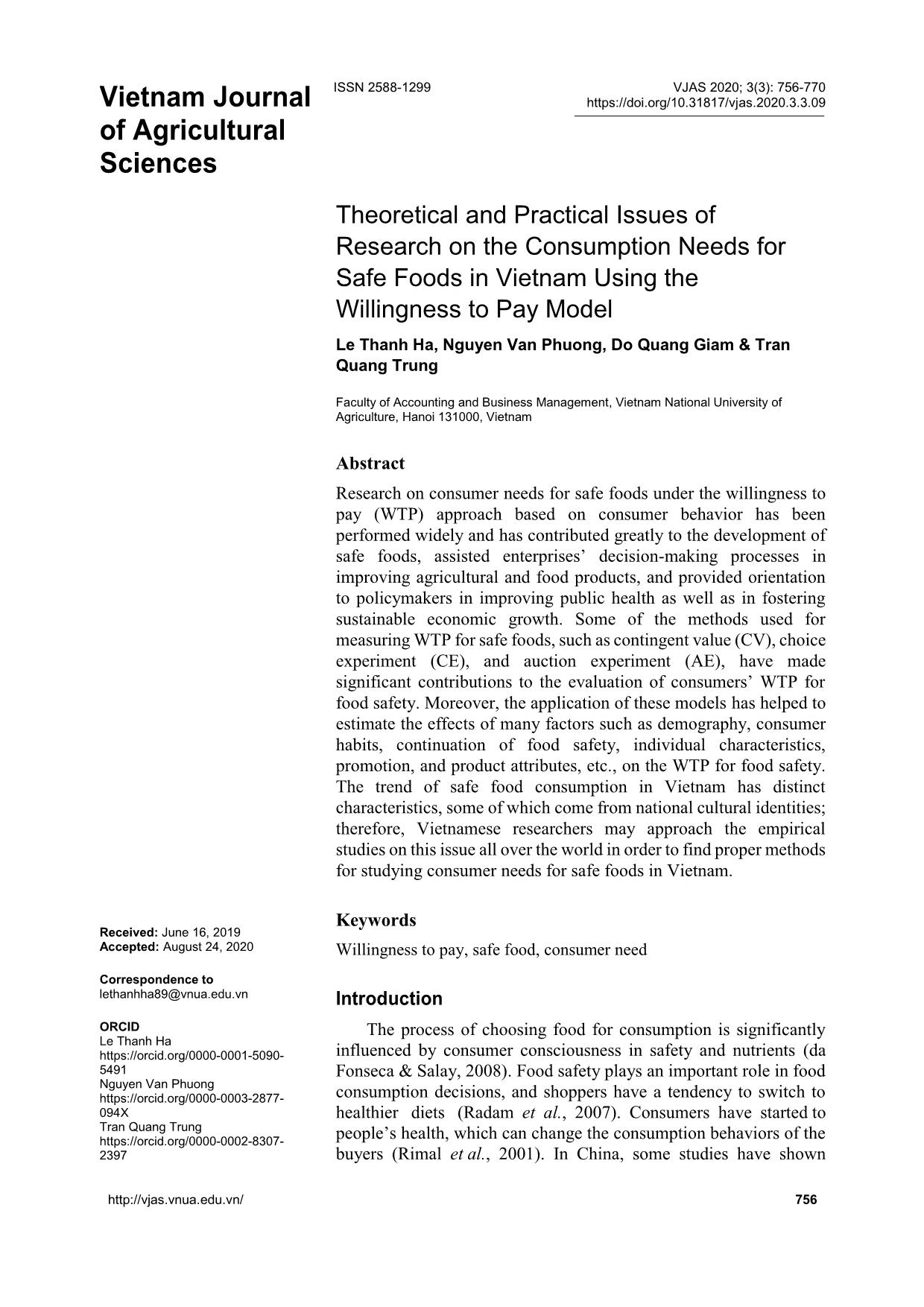
Trang 1
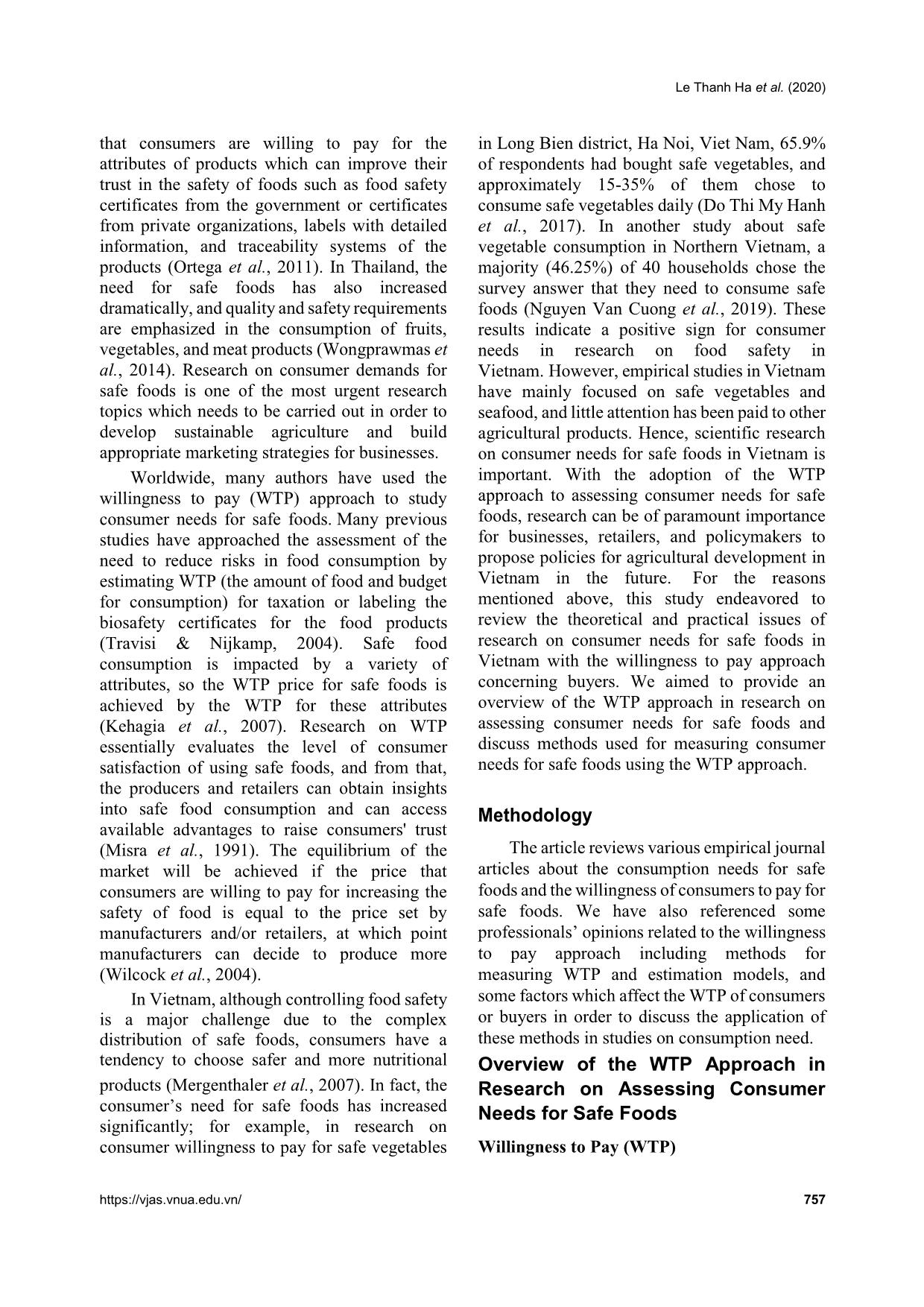
Trang 2
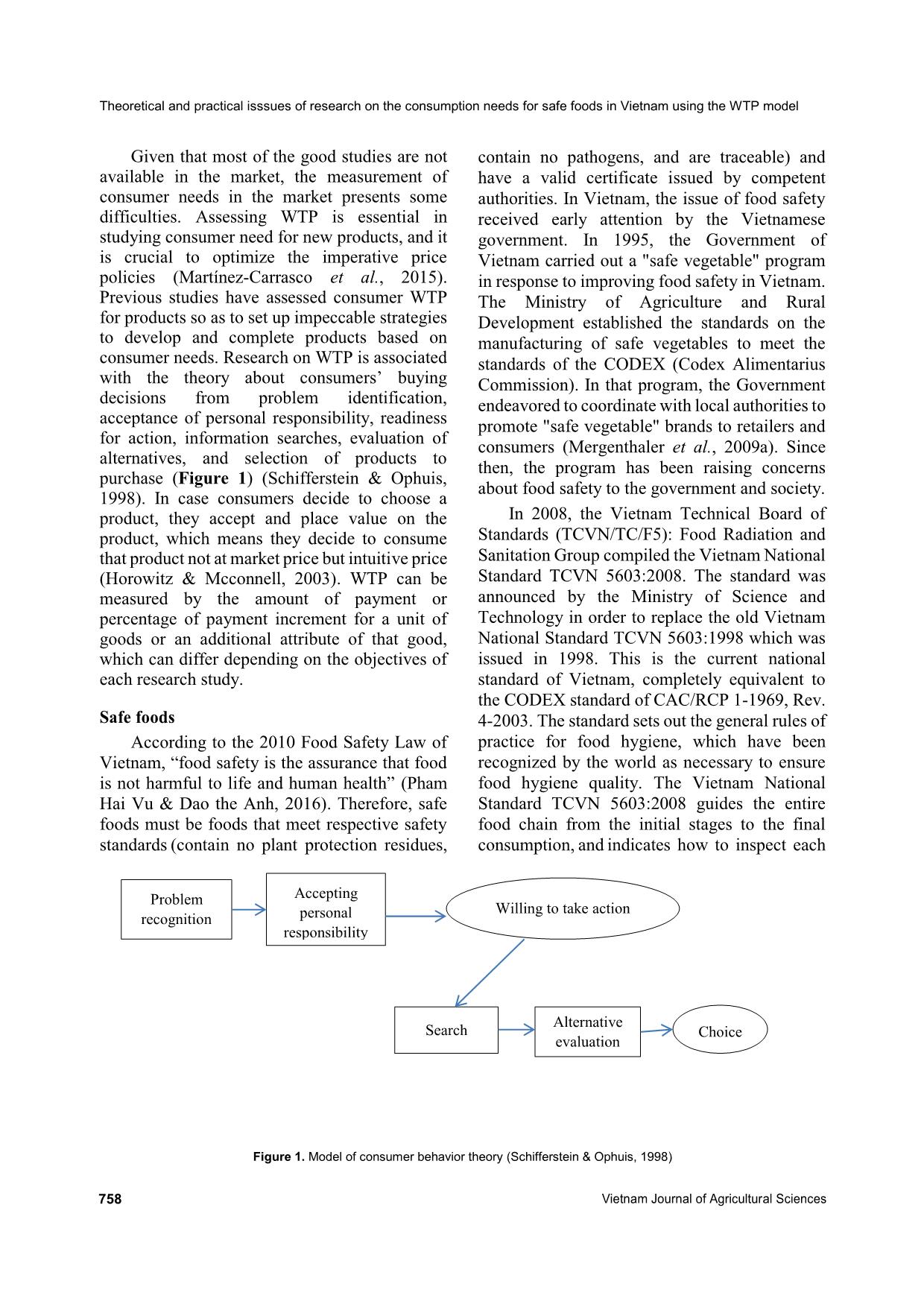
Trang 3
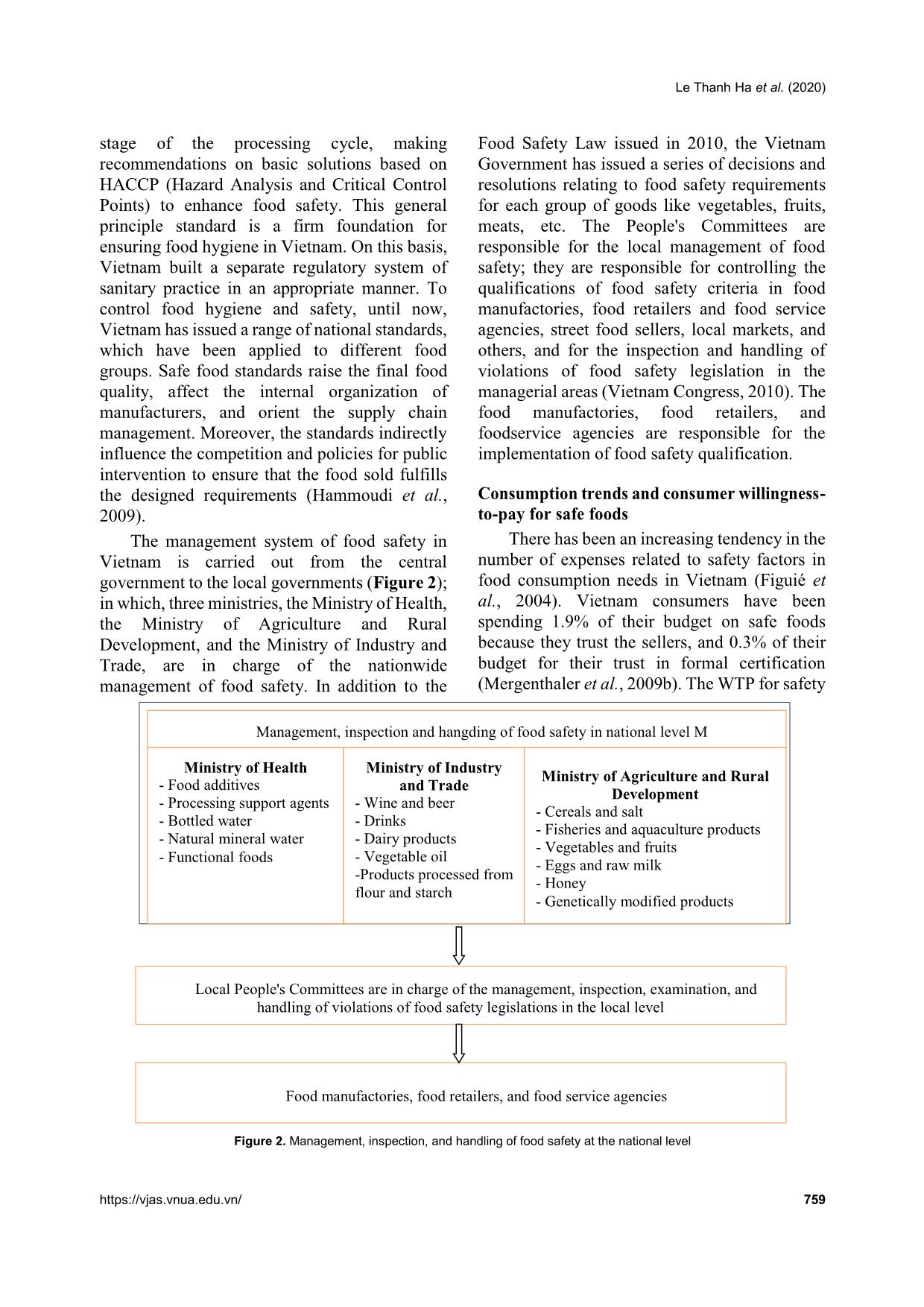
Trang 4
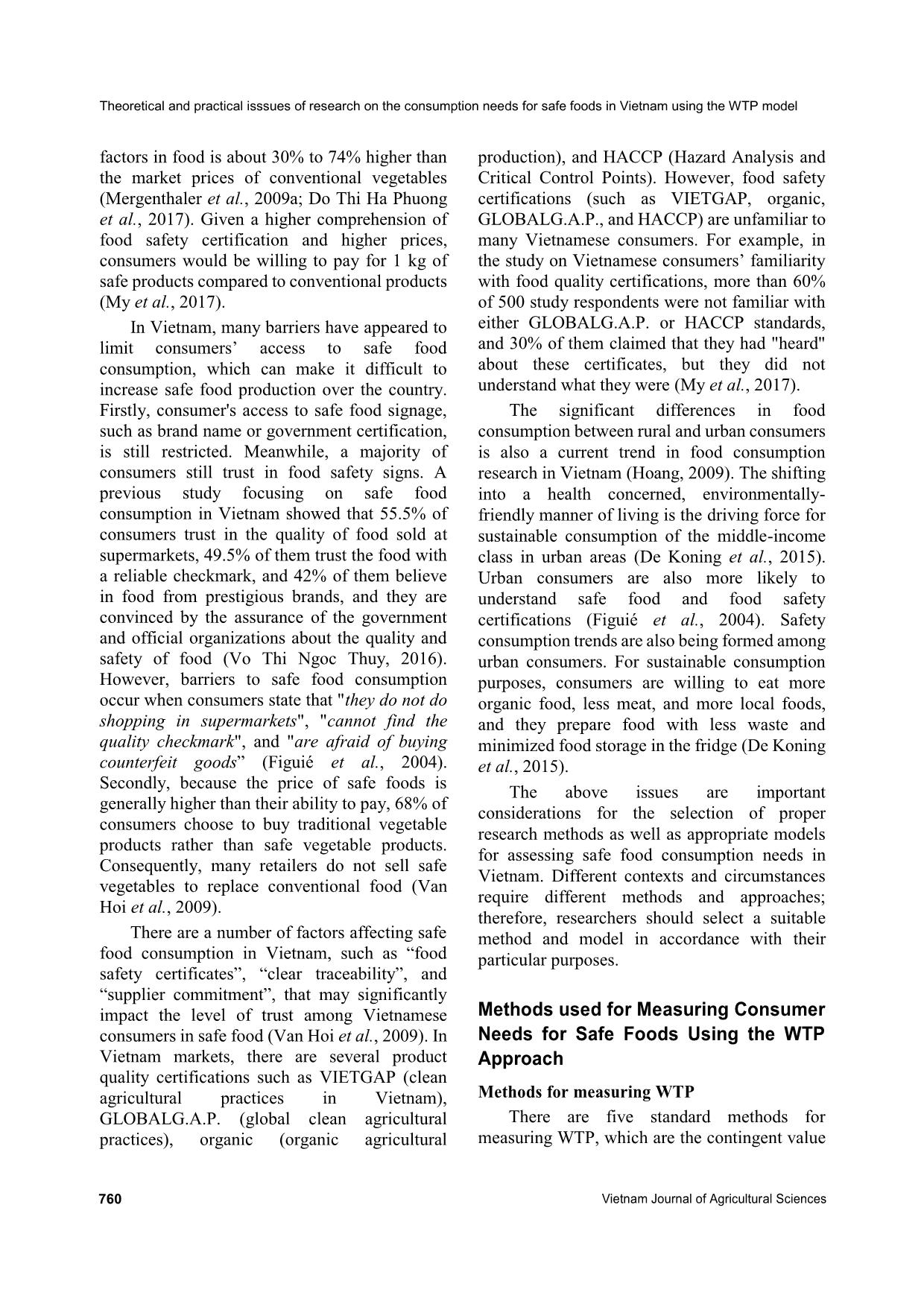
Trang 5
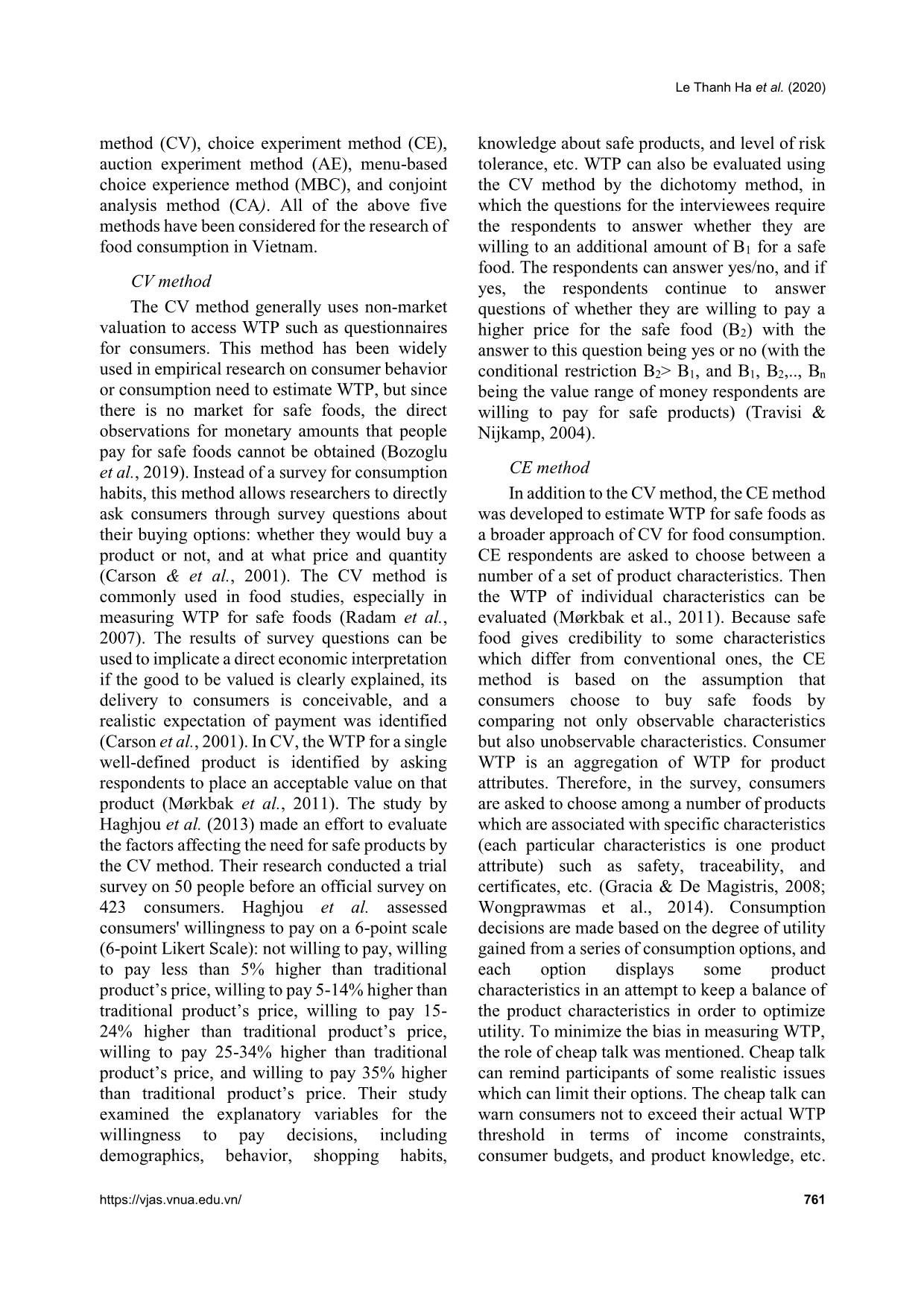
Trang 6
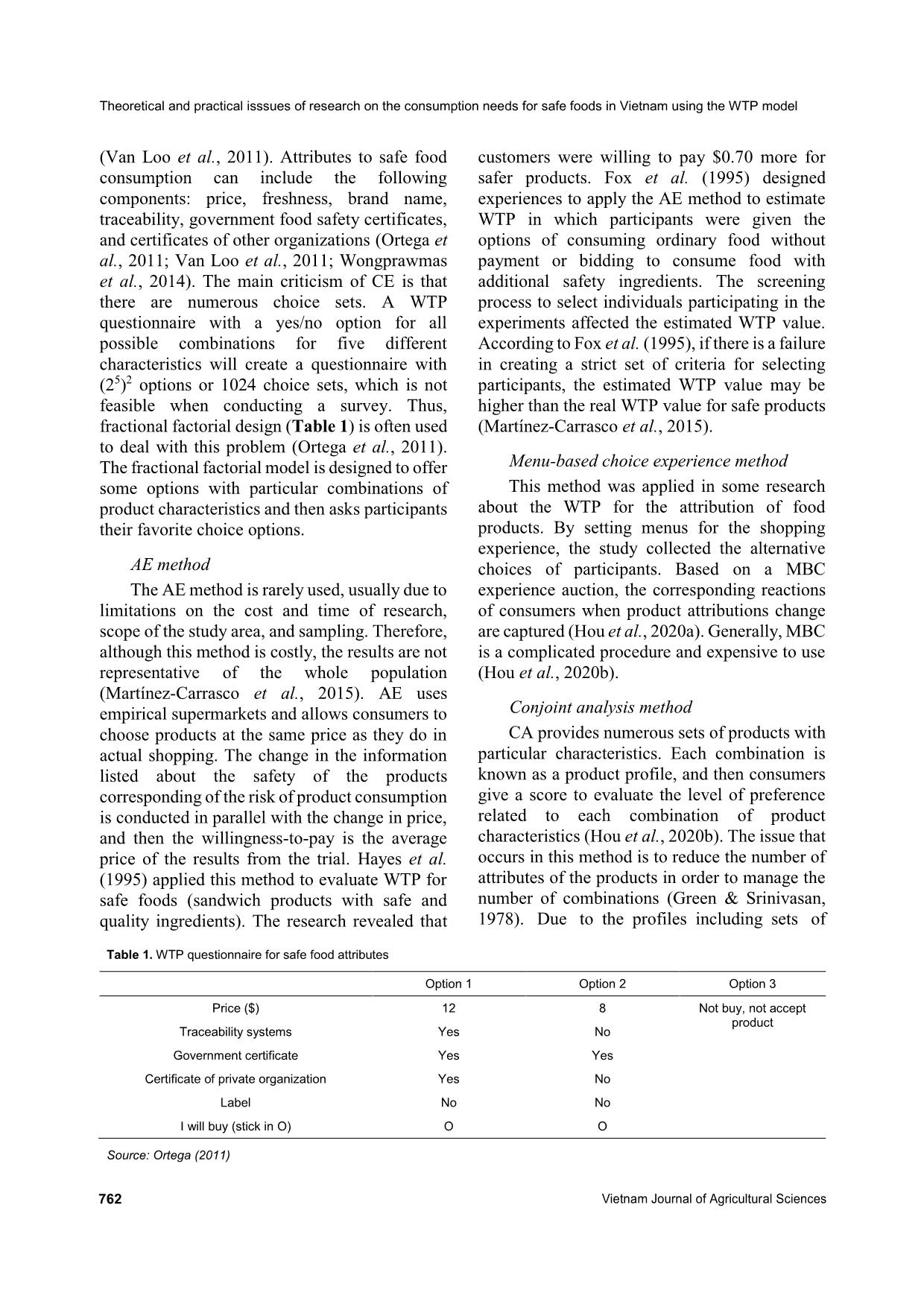
Trang 7
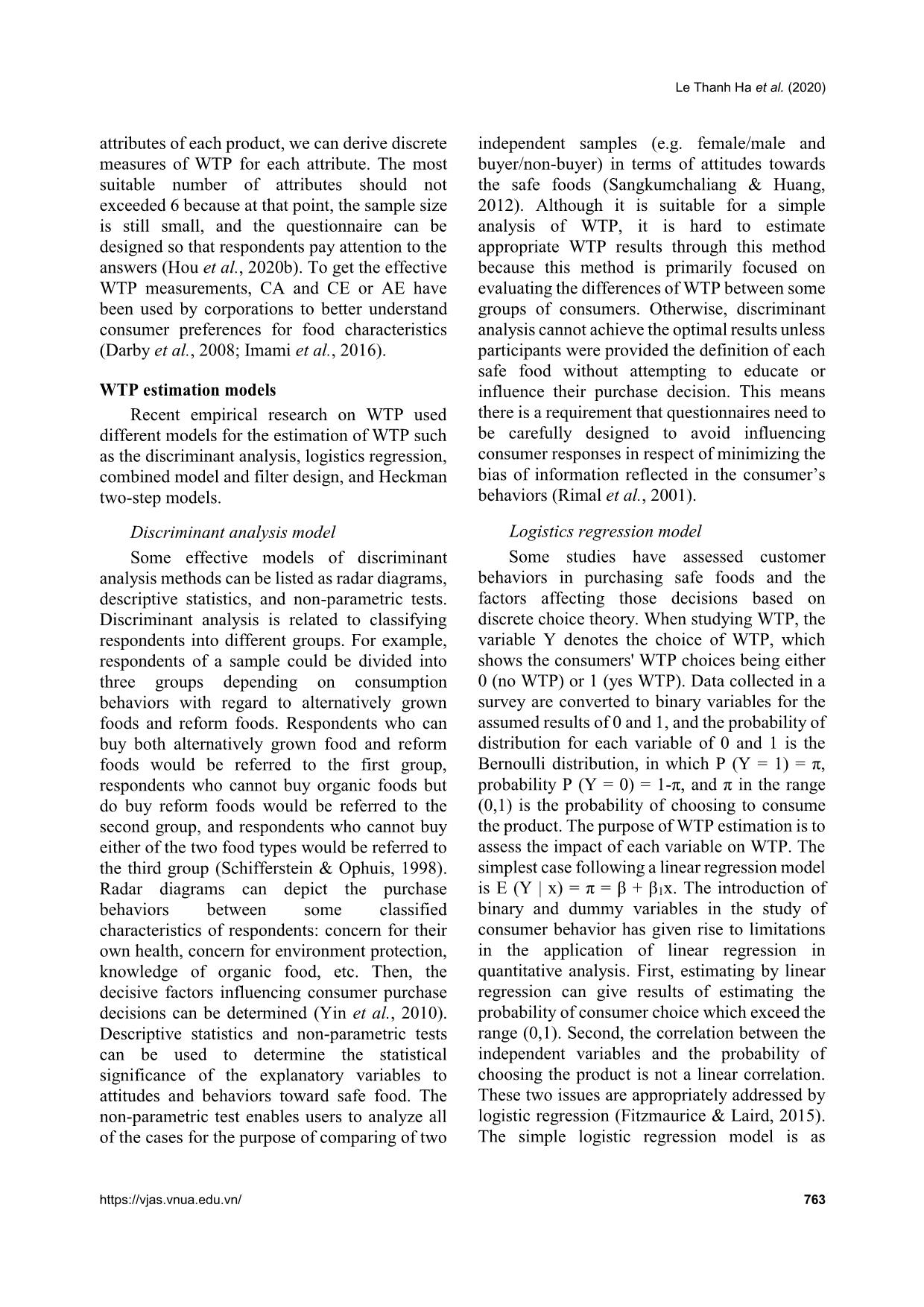
Trang 8
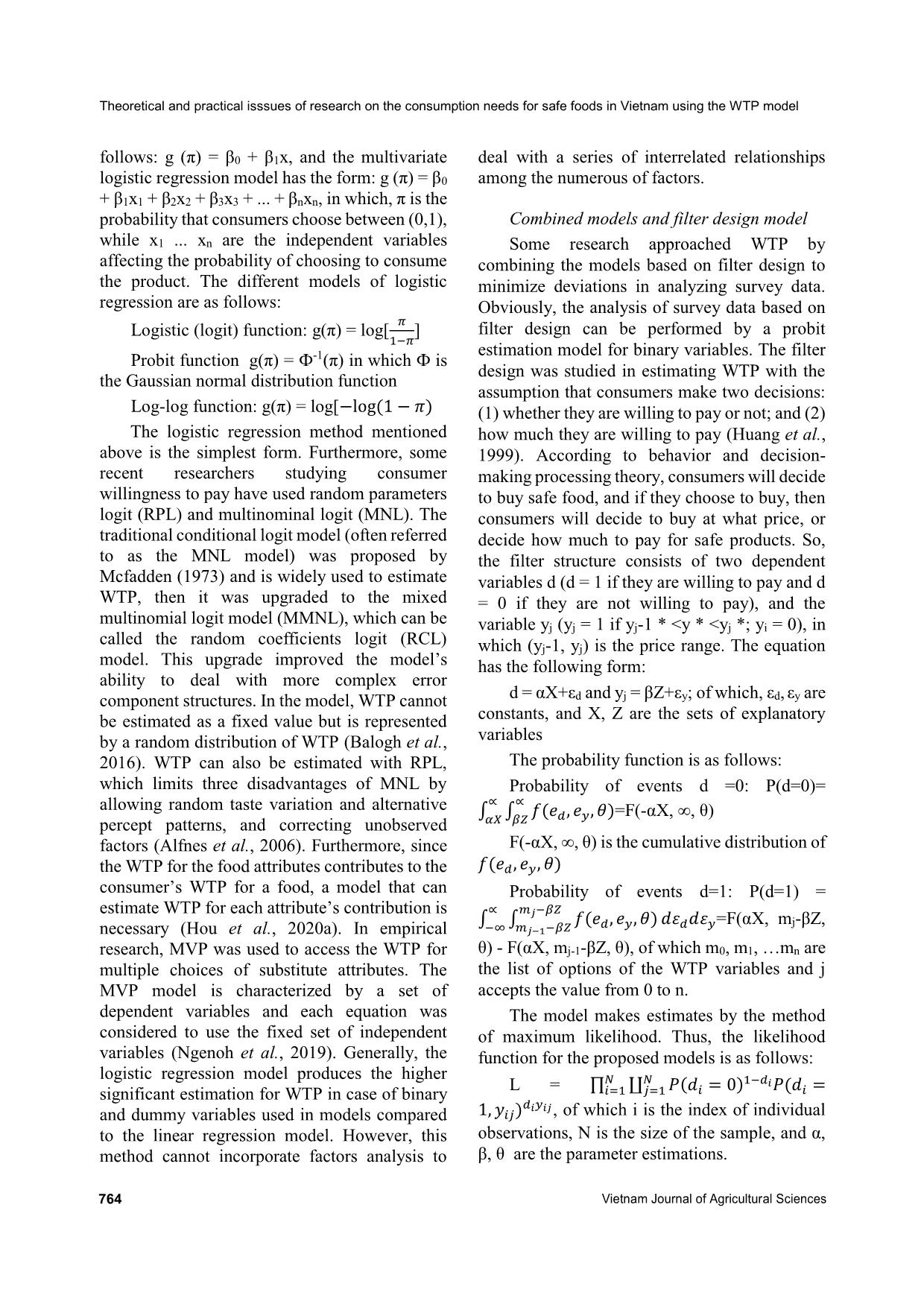
Trang 9
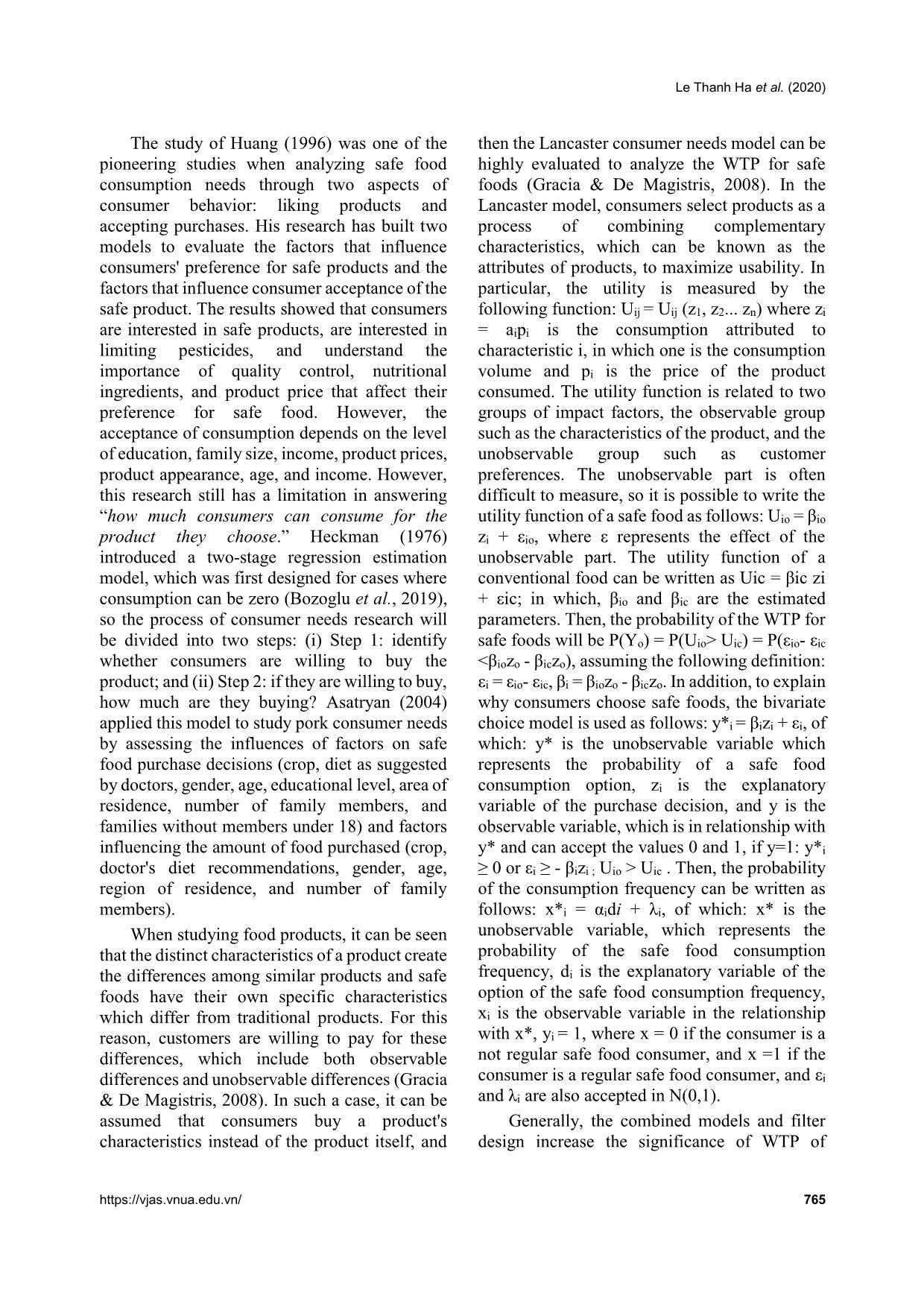
Trang 10
Tải về để xem bản đầy đủ
Tóm tắt nội dung tài liệu: Theoretical and practical issues of research on the consumption needs for safe foods in Viet Nam using the willingness to pay model
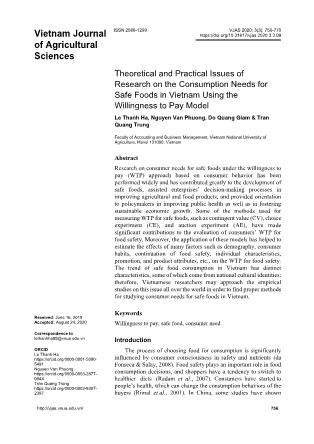
Vietnam Journal of Agricultural Sciences ISSN 2588-1299 VJAS 2020; 3(3): 756-770 https://doi.org/10.31817/vjas.2020.3.3.09 756 Received: June 16, 2019 Accepted: August 24, 2020 Correspondence to lethanhha89@vnua.edu.vn ORCID Le Thanh Ha https://orcid.org/0000-0001-5090- 5491 Nguyen Van Phuong https://orcid.org/0000-0003-2877- 094X Tran Quang Trung https://orcid.org/0000-0002-8307- 2397 Theoretical and Practical Issues of Research on the Consumption Needs for Safe Foods in Vietnam Using the Willingness to Pay Model Le Thanh Ha, Nguyen Van Phuong, Do Quang Giam & Tran Quang Trung Faculty of Accounting and Business Management, Vietnam National University of Agriculture, Hanoi 131000, Vietnam Abstract Research on consumer needs for safe foods under the willingness to pay (WTP) approach based on consumer behavior has been performed widely and has contributed greatly to the development of safe foods, assisted enterprises’ decision-making processes in improving agricultural and food products, and provided orientation to policymakers in improving public health as well as in fostering sustainable economic growth. Some of the methods used for measuring WTP for safe foods, such as contingent value (CV), choice experiment (CE), and auction experiment (AE), have made significant contributions to the evaluation of consumers’ WTP for food safety. Moreover, the application of these models has helped to estimate the effects of many factors such as demography, consumer habits, continuation of food safety, individual characteristics, promotion, and product attributes, etc., on the WTP for food safety. The trend of safe food consumption in Vietnam has distinct characteristics, some of which come from national cultural identities; therefore, Vietnamese researchers may approach the empirical studies on this issue all over the world in order to find proper methods for studying consumer needs for safe foods in Vietnam. Keywords Willingness to pay, safe food, consumer need Introduction The process of choosing food for consumption is significantly influenced by consumer consciousness in safety and nutrients (da Fonseca & Salay, 2008). Food safety plays an important role in food consumption decisions, and shoppers have a tendency to switch to healthier diets (Radam et al., 2007). Consumers have started to people’s health, which can change the consumption behaviors of the buyers (Rimal et al., 2001). In China, some studies have shown Le Thanh Ha et al. (2020) https://vjas.vnua.edu.vn/ 757 that consumers are willing to pay for the attributes of products which can improve their trust in the safety of foods such as food safety certificates from the government or certificates from private organizations, labels with detailed information, and traceability systems of the products (Ortega et al., 2011). In Thailand, the need for safe foods has also increased dramatically, and quality and safety requirements are emphasized in the consumption of fruits, vegetables, and meat products (Wongprawmas et al., 2014). Research on consumer demands for safe foods is one of the most urgent research topics which needs to be carried out in order to develop sustainable agriculture and build appropriate marketing strategies for businesses. Worldwide, many authors have used the willingness to pay (WTP) approach to study consumer needs for safe foods. Many previous studies have approached the assessment of the need to reduce risks in food consumption by estimating WTP (the amount of food and budget for consumption) for taxation or labeling the biosafety certificates for the food products (Travisi & Nijkamp, 2004). Safe food consumption is impacted by a variety of attributes, so the WTP price for safe foods is achieved by the WTP for these attributes (Kehagia et al., 2007). Research on WTP essentially evaluates the level of consumer satisfaction of using safe foods, and from that, the producers and retailers can obtain insights into safe food consumption and can access available advantages to raise consumers' trust (Misra et al., 1991). The equilibrium of the market will be achieved if the price that consumers are willing to pay for increasing the safety of food is equal to the price set by manufacturers and/or retailers, at which point manufacturers can decide to produce more (Wilcock et al., 2004). In Vietnam, although controlling food safety is a major challenge due to the complex distribution of safe foods, consumers have a tendency to choose safer and more nutritional products (Mergenthaler et al., 2007). In fact, the consumer’s need for safe foods has increased significantly; for example, in research on consumer willingness to pay for safe vegetables in Long Bien district, Ha Noi, Viet Nam, 65.9% of respondents had bought safe vegetables, and ... combined models, have helped to evaluate the influences of explanatory factors of WTP for safe foods such as consumer behaviors, health awareness, demography factors, individual characteristics, media and promotion factors, and product contribution factors. Many previous studies have explained the effects of a variety of explanatory variables of consumers’ WTP for safe foods such as age, gender, income, and health concerns, etc. through the different WTP models. They are important references for Vietnam’s safe food consumption assessment. Nevertheless, there are various factors affecting consumption trends for safe foods in Vietnam which are country- specific. Depending on the particular context to achieve the most meaningful findings, it is proposed to follow three steps when calculating the WTP for safe foods which are: (1) choose the appropriate WTP measurement; (2) perform evaluation methods to estimate WTP; and (3) establish the model of explanatory variables of WTP for safe foods. Acknowledgments We would like to express our very great appreciation to the Faculty of Accounting and Business Management, Vietnam National University of Agriculture for their help in offering us the resources in running our analyses. References Alfnes F., Guttormsen A. G., Steine G. & Kolstad K. (2006). Consumers' Willingness to Pay for the Color of Salmon: A Choice Experiment with Real Economic Incentives. American Journal of Agricultural Economics. 88(4): 1050-1061. Asatryan A. A. (2004). Data mining of market information to assess at-home pork demand, Doctor of philosophy, Texas A&M University, 245 pages. Balogh P., Békési D., Gorton M., Popp J. & Lengyel P. (2016). Consumer willingness to pay for traditional food products. Food Policy. 61: 176-184. Bozoglu M., Bilgic A., Huang C. L., Florkowski W. J. & Topuz B. K. (2019). Urban households’ willingness to pay for milk safety in Samsun and Trabzon provinces of Turkey. British Food Journal. 121(10): 2379-2395. Capps O. & Park J. (2002). Impacts of advertising, attitudes, lifestyles, and health on the demand for US pork: A micro-level analysis. Journal of Agricultural and Applied Economics. 34(1): 1-15. Carson R. T., Flores N. E. & Meade N. F. (2001). Contingent Valuation: Controversies and Evidence. Environmental and Resource Economics. 19(2): 173- 210. da Fonseca M. d. C. P. & Salay E. (2008). Beef, chicken and pork consumption and consumer safety and nutritional concerns in the City of Campinas, Brazil. Food Control. 19(11): 1051-1058. Darby K., Batte M. T., Ernst S. & Roe B. (2008). Decomposing Local: A Conjoint Analysis of Locally Produced Foods. American Journal of Agricultural Economics. 90(2): 476-486. De Koning J. I. J. C., Crul M. R. M., Wever R. & Brezet J. C. (2015). Sustainable consumption in Vietnam: an explorative study among the urban middle class. International Journal of Consumer Studies. 39(6): 608- 618. Do Thi Ha Phuong, Doan Thi Mai, Chu Thi Ha & Nguyen Thi Giang (2017). Factors affecting the willingness of consumers to pay for safe food in Thai Nguyen and Thai Nguyen cities. Journal of Science and Technology - Thai Nguyen University. 170(10): 59-64. Do Thi My Hanh, Do Thi tuyet Mai, Tran Trong Nam & Nguyen Trong Tuynh (2017). Factors affecting consumers' willingness to pay for safe vegetable products: Case study in Gia Lam and Long Bien districts. Vietnam Journal of Agricultural Sciences. 13(4): 841-849. Figuié M., Bricas N., Thanh V. P. N., Truyen N. D. & de l'Alimentation E. S.-E. (2004). Hanoi consumers’ point of view regarding food safety risks: an approach in terms of social representation. Vietnam Social Sciences. 3(101): 63-72. Fitzmaurice G. M. & Laird N. M. (2015). Binary Response Models and Logistic Regression. International Encyclopedia of the Social and Behavioral Sciences. 2: 587-595. Fox J. A., Shogren J. F., Hayes D. J. & Kliebenstein J. B. (1995). Experimental auctions to measure willingness Le Thanh Ha et al. (2020) https://vjas.vnua.edu.vn/ 769 to pay for food safety. In: Caswell, J. A. (Ed.). Valuing food safety and nutrition. Food Marketing Policy Center, Department of Agricultural and Resource Economics, University of Connecticut: 128 pages. Gracia A. & De Magistris T. (2008). The demand for organic foods in the South of Italy: A discrete choice model. Food Policy. 33(5): 386-396. Green P. E. & Srinivasan V. (1978). Conjoint analysis in consumer research: issues and outlook. Journal of consumer research. 5(2): 103-123. Haghjou M., Hayati B., Pishbahar E., Mohammad R. R. & Dashti G. (2013). Factors affecting consumers'potential willingness to pay for organic food productions in Iran: case study of tabriz. Journal of Agricultural Science and Technology. 15: 191-202. Hammoudi A., Hoffmann R. & Surry Y. (2009). Food safety standards and agri-food supply chains: an introductory overview. European Review of Agricultural Economics. 36(4): 469-478. Hayes D. J., Shogren J. F., Shin S. Y. & Kliebenstein J. B. (1995). Valuing food safety in experimental auction markets. American Journal of Agricultural Economics. 77(1): 40-53. Heckman J. J. (1976). The common structure of statistical models of truncation, sample selection and limited dependent variables and a simple estimator for such models. In: Annals of economic and social measurement. NBER: 475-492. Hoang L. V. (2009). Estimation of food demand from household survey data in Vietnam.Working Papers from Development and Policies Research Center (DEPOCEN), Vietnam. 2. Horowitz J. K. & McConnell K. E. (2003). Willingness to accept, willingness to pay and the income effect. Journal of Economic Behavior & Organization. 51(4): 537-545. Hou B., Hou J. & Wu L. (2020a). Consumer preferences for traceable food with different functions of safety information attributes: Evidence from a menu-based choice experiment in China. International Journal of Environmental Research and Public Health. 17(1): 146. Hou B., Wu L. & Chen X. (2020b). Market simulation of traceable food in China based on conjoint-value analysis: a traceable case of pork. International Food and Agribusiness Management Review. Special issue: New subtainable food and agribusiness manangement model: 1-12. DOI: 10.22434/ifamr2019.0122. Huang C. L. (1996). Consumer preferences and attitudes towards organically grown produce. European Review of Agricultural Economics. 23(3): 331-342. Huang C. L., Kan K. & Fu T. T. (1999). Consumer willingness to pay for food safety in Taiwan: A binary ordinal probit model of analysis. Journal of Consumer Affairs. 33(1): 76-91. Imami D., Skreli E., Zhllima E., Canavari M., Chan C. & Cela A. (2016). Analysis of consumers’ preferences for typical local cheese in Albania applying conjoint analysis. New Medit. 15(3): 49-55. Janssen M. (2018). Determinants of organic food purchases: Evidence from household panel data. Food quality and preference. 68: 19-28. Kehagia O., Linardakis M. & Chryssochoidis G. (2007). Beef traceability: are Greek consumers willing to pay? EuroMed Journal of Business. 2(2): 173-190. Lanfranchi M., Schimmenti E., Campolo M. G. & Giannetto C. (2019). The willingness to pay of Sicilian consumers for a wine obtained with sustainable production method: An estimate through an ordered probit sample-selection model. Wine Economics and Policy. 8(2): 203-215. Le Thi Phuong Dung & Nguyen Huu Dat (2016). Willingness to pay for water quality improvement in handicraft of Bacninh province, Vietnam. Vietnam Journal of Agricultural Sciences. 14(10): 1608-1617. Le Thi Phuong Dung, Nguyen Huu Dat & Nguyen Thi Huong Giang (2016). Willingness to Pay for Remediation of Water Environmentin Wooden Craff Village of Dong Ky, Bac Ninh. Vietnam Journal of Agricultural Sciences. 14(2): 274-280. Liu R., Pieniak Z. & Verbeke W. (2013). Consumers' attitudes and behaviour towards safe food in China: A review. Food Control. 33(1): 93-104. Martínez-Carrasco L., Brugarolas M., Martínez-Poveda A. & Ruiz-Martínez J. J. (2015). Comparing hypothetical versus non-hypothetical methods for measuring willingness to pay in a food context. Spanish Journal of Agricultural Research. 13(4-e0109): 1-12. McFadden D. (1973). Conditional logit analysis of qualitative choice behavior. In., University of Califorina at Berkeley: 105-142. Mergenthaler M., Qaim M. & Weinberger K. (2007). Changing Consumer Buying Habits in Developing Countries: A Disaggregate Demand Analysis for Fruits and Vegetables in Vietnam. Mergenthaler M., Weinberger K. & Qaim M. (2009a). Consumer valuation of food quality and food safety attributes in Vietnam. Review of Agricultural Economics. 31(2): 266-283. Mergenthaler M., Weinberger K. & Qaim M. (2009b). The food system transformation in developing countries: A disaggregate demand analysis for fruits and vegetables in Vietnam. Food Policy. 34(5): 426-436. Michaelidou N. & Hassan L. M. (2010). Modeling the factors affecting rural consumers’ purchase of organic and free-range produce: A case study of consumers’ from the Island of Arran in Scotland, UK. Food Policy. 35(2): 130-139. Misra S. K., Huang C. L. & Ott S. L. (1991). Consumer willingness to pay for pesticide-free fresh produce. Western Journal of Agricultural Economics. 218-227. Mørkbak M. R., Christensen T. & Gyrd-Hansen D. (2011). Consumers’ willingness to pay for safer meat depends on the risk reduction methods – A Danish case study Theoretical and practical isssues of research on the consumption needs for safe foods in Vietnam using the WTP model 770 Vietnam Journal of Agricultural Sciences on Salmonella risk in minced pork. Food Control. 22(3-4): 445-451. My N. H. D., Rutsaert P., Van Loo E. J. & Verbeke W. (2017). Consumers’ familiarity with and attitudes towards food quality certifications for rice and vegetables in Vietnam. Food Control. 82: 74-82. Ngenoh E., Kurgat B. K., Bett H. K., Kebede S. W. & Bokelmann W. (2019). Determinants of the competitiveness of smallholder African indigenous vegetable farmers in high-value agro-food chains in Kenya: A multivariate probit regression analysis. Agricultural and Food Economics. 7(1): 3-12. DOI: 10.1186/s40100-019-0122-z. Ngo Minh Hai & Vu Quynh Hoa (2016). Consumer perception of organic food: a case study in Hanoi city. Vietnam Journal of Agricultural Sciences. 14(9): 1466-1474. Nguyen Minh Duc & Dang Thanh Liem (2015). Preference and attitude of consumers in HCMC for processed aquatic products. Journal of scientific research. 9: 14- 23. (in Vietnamese). Nguyen Thi Thu Quynh, Nguyen Tat Thang & Bui Thi Khanh Hoa (2018). Awareness and Willingness-to- Pay for Clean Water Servicein Thuy Nguyen District, Hai Phong City. Vietnam Journal of Agricultural Sciences. 16(8): 763-772. Nguyen Van Cuong, Tran Dong Lap & Pham Thi Minh Tam (2019). Economic analysis of safe vegetable production and measurement of willingness to pay. Applying technology - connecting value chains, reducing risks for agricultural products. Forum of Mekong connect 2019. 89-101. Ortega D. L., Wang H. H., Wu L. & Olynk N. J. (2011). Modeling heterogeneity in consumer preferences for select food safety attributes in China. Food Policy. 36(2): 318-324. Pham Hai Vu & Dao The Anh (2016). Agricultural food safety: Some knowledge about products, distribution systems and government policies. Agricultural publisher. 6-10.. Prakash G., Singh P. K. & Yadav R. (2018). Application of consumer style inventory (CSI) to predict young Indian consumer’s intention to purchase organic food products. Food quality and preference. 68: 90-97. Radam A., Cher L. Y., Shamsudin M. N., Mohamed Z. & Selamat J. (2007). Consumers’ willingness to pay towards food safety: The case of meat consumption. Economic and Technology Management Review. 2: 63-74. Rimal A., Fletcher S. M., McWatters K. H., Misra S. K. & Deodhar S. (2001). Perception of food safety and changes in food consumption habits: a consumer analysis. International Journal of Consumer Studies. 25(1): 43-52. Sangkumchaliang P. & Huang W.-C. (2012). Thai Organic Food Demographics, Attitudes and Behavior. International Journal of the Computer, the Internet and Management. 20(3): 7-11. Schifferstein H. N. J. & Ophuis P. A. M. O. (1998). Health- related determinants of organic food consumption in the Netherlands. Food quality and preference. 9(3): 119-133. Thompson G. D. & Kidwell J. (1998). Explaining the choice of organic produce: cosmetic defects, prices, and consumer preferences. American Journal of Agricultural Economics. 80(2): 277-287. Travisi C. M. & Nijkamp P. (2004). Are Italians willing to pay for agricultural environmental safety? A Stated choice approach. Food Safety in a Dynamic World. The 84th EAAE Seminar. 1-20. Van Hoi P., Mol A. P. J. & Oosterveer P. J. M. (2009). Market governance for safe food in developing countries: The case of low-pesticide vegetables in Vietnam. Journal of Environmental Management. 91(2): 380-388. Van Loo E. J., Caputo V., Nayga Jr R. M., Meullenet J.-F. & Ricke S. C. (2011). Consumers’ willingness to pay for organic chicken breast: Evidence from choice experiment. Food quality and preference. 22(7): 603- 613. Vo Thi Ngoc Thuy (2016). The impact of safety food labels on customer behavior with products of private labels. VNU Journal of Science: Economics and Business. 32(4 ): 59-66. Wang J., Ge J. & Ma Y. (2018). Urban Chinese consumers’ willingness to pay for pork with certified labels: A discrete choice experiment. Sustainability. 10(3): 1-14. Wilcock A., Pun M., Khanona J. & Aung M. (2004). Consumer attitudes, knowledge and behaviour: a review of food safety issues. Trends in Food Science & Technology. 15(2): 56-66. Wongprawmas R., Canavari M. & Waisarayutt C. (2014). Are Thai consumers willing to pay for food safety labels? Choice experiment on fresh produce. The EAAE conference "Agri-Food and Rural Innovations for Healthier Societies", August 26-29, 2014. Ljubljana, Slovenia: 1-14. Xu L. & Wu L. (2010). Food safety and consumer willingness to pay for certified traceable food in China. Journal of the Science of Food and Agriculture. 90(8): 1368-1373. Yin S., Wu L., Du L. & Chen M. (2010). Consumers' purchase intention of organic food in China. Journal of the Science of Food and Agriculture. 90(8): 1361-1367. Yong A. G. & Pearce S. (2013). A beginner’s guide to factor analysis: Focusing on exploratory factor analysis. Tutorials in Quantitative Methods for Psychology. 9(2): 79-94.
File đính kèm:
 theoretical_and_practical_issues_of_research_on_the_consumpt.pdf
theoretical_and_practical_issues_of_research_on_the_consumpt.pdf

